So, you’re wanting to get the hang of value and contrast? Then you’ve come to (almost) the right place. It’s simple really, once you get the hang of it.
I myself neglected learning how to shade correctly for years in favor of increasing other skills instead. But I soon learned that value really adds depth to an object, and decided to pursue learning this on my own.
In short, after messing around a bit, I learned in near two days, just from experimentation (and being a fast learner). And now I pass on what I’ve learned to willing others. Let’s do this, F**K YEA!!
PART I – The Doodle
The doodle is the best way to start off, you need to have -something- visualized. Some people also do silhouettes to start them off, although all the detail isn’t yet in place, so that makes it hard unless you have a clear vision of everything.
I personally start off with a little sketch/doodle, all details already drawn in and ready to be filled up with value.
I’ll get to something cool later, but for right now, we start with the basics. And that means simple geometric shapes i.e. cubes, cones, spheres etc. I’ve doodled an example of those three.

PART II – Blocking In And Choosing Light Direction/Source
This is the part where I usually choose where the light is coming from. Two of the easiest ones to do are from behind, or from the side, but it’s best to practice with every direction you can.
First I block in with shades of gray, using a hard edged brush. The lighter the gray, the more light is hitting. When something is completely saturated with white, it’ll look mostly just white. This takes practice and some fiddling around.
Do this on a separate layer, and on top of the sketch, the lines are only there to hold the shape of the object. Mess with the opacity so that you can see the lines through the gray, but can also still tell your darks from your lights.
And don’t try to be so perfect in the stage, be as messy as you want, just keep a general idea in your head of where the light is hitting and you’ll be fine.

PART III – Cleaning Up, Giving Prescence
Ok, so now you have a really ugly looking shape with really ugly looking shading, which is overall really ugly looking. Right.
So now it’s time to make it a bit prettier.
Clean up the gray that falls outside the shape by erasing it. It doesn’t have to be too good, just good enough.
Next, make a new layer. This is where edges, midtones, lightest lights, and darkest darks get semi-defined.
Take a medium sized soft brush (low flow and low opacity if you’re using PhotoShop. I’m Using SketchBook Pro 2010) and go over the object lightly with either white or black. Depending on where your light is hitting, and where your shadows are.
Don’t go overboard with it.
I also forgot something *facepalms*. At this point, or even BEFORE this step, I usually lay down a soft gray background to contrast more with the light. So if you haven’t done this, do it on either the same layer, or a new one. If you do it on the same layer you’ll probably get a better result, as you can still go over the edges and define them even more.
I also do a soft shadow and some secret ninja stuff you’ll have to spot and try on your own.

PART IV – Detailing And Not Going Insane
And by this I’m mostly talking to myself…I’m a guy with a taste for detail, what can I say, I go crazy with the possibilities sometimes.
Anyway, for tutorials sake I’ll throw a few scrapes and cuts into the shapes.
I used this to teach myself how to get used to other things on the same object interacting with the same light…it’s complicated to explain, so I’ll draw it instead.
As you can see, by drawing little cracks all over the place, this gives you a chance to experience with how the light interacts and practice more, instead of redrawing the same object over and over and OVER. Although some may prefer to do that, all the same.
I’ve also worked some strange forbidden magic to make the results of mine look a bit better…hint: draw, blend, go over, blend, go over, wash, rinse, repeat.
Basically what I just said is in order to make the cracks blend in with the object instead of sticking out, I went over the area with a gray of the surrounding shade, and went over some areas once again, to keep it both blended, yet sharp. Get it?
Of course you don’t, this takes time.
I create a new layer, this will most likely be the final layer, but sometimes I add some extras.
Right now, I work with a very small brush, if you’re not using a graphics tablet and don’t have pressure sensitivity on, well…this will be tough. You can skip this though.

PART V – And From Here
You’ll know when you’re finished. As an artist I’m sure you’ll keep going back and forth messing with stuff until it looks just right, and if you don’t do that…maybe you should.
Also, with the full grayscale drawing done, you don’t have to worry about too much when it comes to coloring. A nice combination of overlay, multiply or color layers should do the job. Experiment.
At this time, you can choose to either keep or delete your sketch layer. Why? Because amazingly, nearly no lines were used, WOOT! Because that increases the realism, although for style, I sometimes outline my stuff with a bright white outline.
It’s whatever you want.
And here’s that something cool I promised…cba, didn’t finish, whatever.

Protip I learned from Cype and Rei: Go from dark to light, not light to dark. Unless you’re that awesome.
Article source : www.mangatutorials.com/2011/value-sketch-with-gunzy-tutorial

































 If you haven’t done so already, make sure you save your work by
clicking on File > Save As…. Type in the name of your work and press
OK. This will create a file with a cpg file which is associated with
Manga Studio, a thumbnail image of your work, a layer folder and a pff
file. Save a lot and save frequently! If you want to be extra careful,
you can make a backup of your work whether it’s via a Flash drive, CD or
online.
If you haven’t done so already, make sure you save your work by
clicking on File > Save As…. Type in the name of your work and press
OK. This will create a file with a cpg file which is associated with
Manga Studio, a thumbnail image of your work, a layer folder and a pff
file. Save a lot and save frequently! If you want to be extra careful,
you can make a backup of your work whether it’s via a Flash drive, CD or
online. Select what you want to show up or not show up and hit Print at the
bottom to send it to your printer. Hit OK if you would like to keep
those settings for future print jobs.
Select what you want to show up or not show up and hit Print at the
bottom to send it to your printer. Hit OK if you would like to keep
those settings for future print jobs.
 Lettering your work is as easy as typing in a word processor. All you
have to do to get started is to hit the Text icon in the Tools palette
indicated with the letter “A”. Then click on the area you want to place
your dialogue. This will pop up a window which has multiple options from
font type, font size, alignment and so on.
Lettering your work is as easy as typing in a word processor. All you
have to do to get started is to hit the Text icon in the Tools palette
indicated with the letter “A”. Then click on the area you want to place
your dialogue. This will pop up a window which has multiple options from
font type, font size, alignment and so on. I’d like to take this time to remind you to keep your text and all
important images within the main blue box at the center. This is what’s
called the Safety Zone. Anything beyond that may get cropped off when
you’re printing and publishing your work.
I’d like to take this time to remind you to keep your text and all
important images within the main blue box at the center. This is what’s
called the Safety Zone. Anything beyond that may get cropped off when
you’re printing and publishing your work. To use this feature, you have to open up your Material Folder. At the
Tool Bar, you will see a yellow folder at the right side. Click on that
to open up the Materials Folder window as seen below. On the left side
under Default, you will see a folder called “Word Balloons”. Click on
that to see some ready-made balloons that comes standard with the
software.
To use this feature, you have to open up your Material Folder. At the
Tool Bar, you will see a yellow folder at the right side. Click on that
to open up the Materials Folder window as seen below. On the left side
under Default, you will see a folder called “Word Balloons”. Click on
that to see some ready-made balloons that comes standard with the
software.







 Word Balloons allows your characters to talk but not only that, it is
also is a way to represent how they are feeling. The three most standard
balloons are the speech with it’s round shape, shout with multiple
sharp edges and the thought balloon with it’s cloud-like visual.
Balloons can also be used for sound effects though that is much more
rare.
Word Balloons allows your characters to talk but not only that, it is
also is a way to represent how they are feeling. The three most standard
balloons are the speech with it’s round shape, shout with multiple
sharp edges and the thought balloon with it’s cloud-like visual.
Balloons can also be used for sound effects though that is much more
rare.
 If
you don’t like the placement of your balloon, you can move it around by
using the Move Layer tool as seen on the right. Make sure you select
the layer where the balloon or else something else will move which you
don’t want to happen.
If
you don’t like the placement of your balloon, you can move it around by
using the Move Layer tool as seen on the right. Make sure you select
the layer where the balloon or else something else will move which you
don’t want to happen. Making shout balloons will require mostly the line tool while thought
balloons will require the curve and ellipse tool. After you’ve made the
basic shape, fill them in with white.
Making shout balloons will require mostly the line tool while thought
balloons will require the curve and ellipse tool. After you’ve made the
basic shape, fill them in with white. Nothing shows action like speed and focus lines. Speed lines are
multiple lines that denotes movement while focus lines are like
bursts of light that focus on an aspect on the page.
Nothing shows action like speed and focus lines. Speed lines are
multiple lines that denotes movement while focus lines are like
bursts of light that focus on an aspect on the page.

 Random — will randomly place the lines depending on which setting you will place so it looks less uniform and more hand-made.
Random — will randomly place the lines depending on which setting you will place so it looks less uniform and more hand-made.
Join The Community